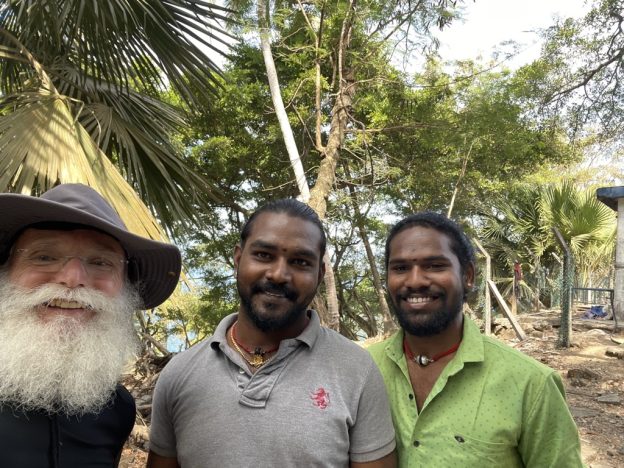-
A month and a half of South India
(Translated from Slovenian to English with ChatGPT) Introduction Moving around Residence Eating Bangalore attractions Raggiguda Ajaneya Temple Lalbagh and Cubon Park the Palace Tipu’s Summer Palace Bannerghata Zoo Wayanad and a real safari trip Edakkal Caves Pookode Lake Mountain Shadows Resort Kabini River Lodges Andaman Islands Cellular Jail Ross Island Havelock Island SeaShell Resort Taj…
-
Miklova šala
Miklova šala uprizoritev v sezoni 2018/19, Turistično društvo Sv. Vid v Šentvidu pri Lukovici Song: Glej no glej vas ljudi, le zakaj ste sem prišli, kaj bi radi delali tu med Štangar-štangarji? Zgornja Štanga je ta vas in o njej se širi glas, da so tu, ravno tu že nastale, nove, nove, nove nam Butale!…
-
Pelčev pasijon ali intervju s Stanitovim alter egom
Avtor: Stanko Pelc; Asistentka avtorja: Maša Pelc Režija Režiser: Stanko Pelc Asistentka režiserja: Maša Pelc Zasedba Groga: Stanko Pelc Maša: Maša Pelc Zganarel: Stanko Pelc Stane: Stanko Pelc Miša: Maša Pelc Goležev Stani (Stanitov alter ego): Stanko Pelc Publika v studiu gledalci Recenzija Recenzentka: Julija Pelc slika – preduvod Groga: Kaj gledate, kaj zijate vame,…
-
Prvič, zadnjič in nikoli več
Stanko Pelc Prvič, zadnjič in nikoli več Napisano po zgodbi glavnega junaka Jurčičevih in Kersnikovih Rokovnjačev. Nastopata berač Groga in Mozolova Jerica. Jerica: Vam je slabo? Naj vam pomagam! Groga: Pusti me, meni bo dobro, ko se zvrnem v grob in bržčas mi ne bo več treba dolgo čakat’ na to. Le upam lahko, da…
-
O monodrami Rokovnjaška zgodba berača Groge in njenih uprizoritvah
Uvod Groga je junak Jurčičevega in Kersnikovega romana Rokovnjači in dramatizacij te zgodbe. Na Brdu pri Lukovici je Turistično društvo 25. in 26. junija 1960 priredilo 1. Rokovnjaški tabor in ob tej priložnosti na prostem uprizorilo – Rokovnjače. Prireditev je postala tradicionalna in dobro znana širom Slovenije. Leta 1975 je bila v okviru te prireditve…
-
Rokovnjaška zgodba berača Groge
Monodrama, po motivih Jurčič-Kersnikovih Rokovnjačev Nastopa: berač Groga; z njim so gostje (gledalci), s katerimi si deli gostinsko sobo! Groga: Kaj gledate, kaj zijate vame? Se vam gnusi star in razcapan berač, kaj? Pa ne, da vam je neprijetno v isti sobi z menoj? Saj vem, kaj si mislite pa mi je eno figo mar…
-
Lanina trilogija
Kokoška Lana na potepu Fina je kokoška Lana, zjutraj vedno je zaspana, s trudom in počasi vstane, se pretegne in oči pomane. Postelja še ni postlana, že je na sprehodu Lana. Spomni se, da ni še jedla, rada bi vsaj črva snedla. Prav tedaj na pot pririne, nihče drug kot črv Bine. Že mu zadnja…
-
V spomin na Igorja Lipovška – predsednika Zveze geografov Slovenije
Govor na žalni seji Zveze geografov Slovenije in Društva učiteljev slovenije, 14. 9. 2021 v spomin na prezgodaj preminulega predsednika ZGS in enega najbolj dejavnih članov DUGS Avgust, ali po slovensko veliki srpan, je mesec umeščen v srednji del leta, mesec, v katerem se poletje počasi preveša v jesen in letos mesec, v katerem smo…
-
Ob zadnjem slovesu od mojega najboljšega prijatelja
Plečnikove Žale, 12. velikega srpana, 2021 Draga Marjana, dragi Pavel, spoštovani sorodniki, prijatelji in znanci – vsi, ki ste se zbrali ob tej žalostni uri, uri zadnjega slovesa od Igorja Lipovška Lenasija, večini poznanega tudi po vzdevku Lipe! Nikoli si nisem mislil, da bom imel govor na njegovem pogrebu. Sam pri sebi sem zase že…
